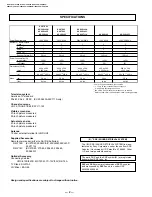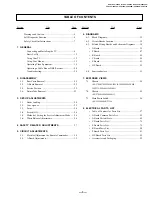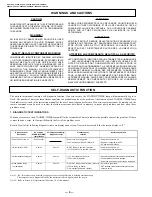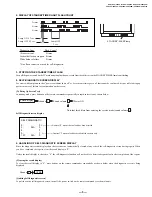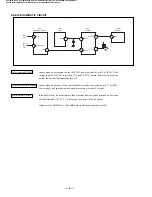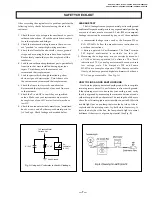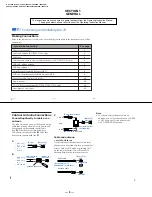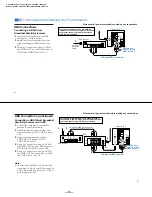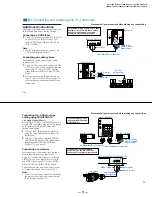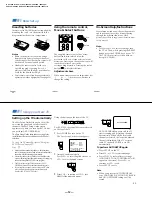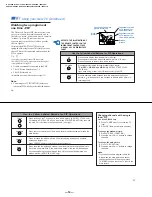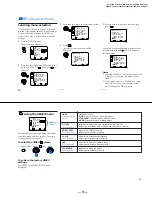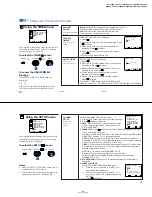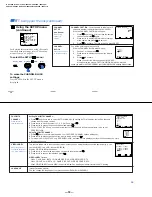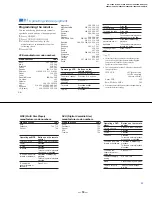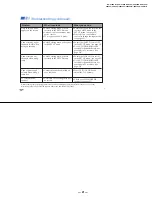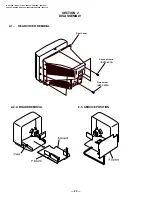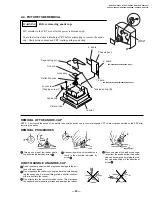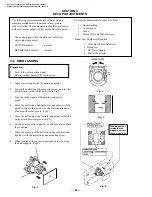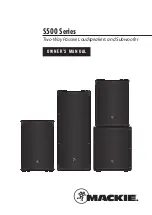
—
9
—
KV-27S40 / 27S45 / 27S65 / 29SL40 / 29SL40A / 29SL40C/
29SL45 / 29SL65 / 29SL65C/ 29XL40M / 29XL40P / 29XT11A
6
Connecting and Installing the TV (continued)
Cable Box Connections
*Cable box
Cable
OUT
IN
(Rear of TV)
VHF/UHF
TO CONVERTER
*Cable box
VHF/UHF
(Rear of TV)
AUX
75-ohm coaxial
cable (not supplied)
CATV cable
(unscrambled channels)
(signal)
Some pay cable TV systems use scrambled or
encoded signals that require a cable box* to
view all channels.
scrambled
channels
If you will be controlling all channel selection
through your cable box, you should consider using
the CHANNEL FIX feature discussed on page 23.
If you are connecting a cable box through the AUX input and would
like to switch between the AUX and normal (CATV) input you should
consider using the CHANNEL FIX feature discussed on page 23.
Cable box
1
Connect the coaxial connector from your
cable or antenna to the IN on your cable
box.
2
Using a coaxial cable, connect OUT on
your cable box to VHF/UHF on your TV.
Cable box and cable
• KV-27S65, 27V65 only
For this set up, you can switch between
scrambled channels (through your cable box),
and normal (CATV) channels by pressing
ANT on your remote control.
Notes
• Your Sony remote control can be
programmed to operate your cable box.
(see page 28)
• When using PIP, you cannot view the
window picture with the AUX input.
7
Disconnect all power sources before making any connections.
VCR must be connected and
turned on to operate PIP
(KV-27S45, 27V45 only).
VCR Connections
AUDIO OUT
(VAR/FIX)
VIDEO IN
1
2
VHF/UHF
S VIDEO
VIDEO
L
R
AUDIO
(MONO)
AUDIO R AUDIO L VIDEO
S VIDEO
LINE
OUT
OUT
IN
Coaxial cable
(Rear of TV)
VMC-810S/820S (not supplied)
Cable
VCR
3
1
2
AUDIO-R (red)
AUDIO-L (white)
VIDEO (yellow)
AUDIO OUT
(VAR/FIX)
VIDEO IN
1
2
VHF/UHF
S VIDEO
VIDEO
L
R
AUDIO
(MONO)
AUDIO R AUDIO L VIDEO
S VIDEO
LINE
OUT
OUT
IN
OUT
IN
VMC-810S/820S (not supplied)
Cable box
Splitter
(not supplied)
3
AUDIO-R (red)
AUDIO-L (white)
VIDEO (yellow)
VCR
Cable
Coaxial cable
2
1
For optimum picture quality, use S VIDEO instead of
the yellow A/V cable. S Video does not provide sound,
your audio connectors must still be connected.
Connecting an antenna/cable TV
system with a VCR
(Rear of TV)
You will need a splitter (not supplied) for the
following connection.
1
Connect the single (input) jack of the splitter
to your incoming cable connection. Connect
the other two (output) jacks (using coaxial
cable) to IN on your cable box and VHF/UHF
on your TV.
2
Using a coaxial connector, connect OUT on
your cable box to IN on your VCR.
3
Using A/V connectors, connect AUDIO and
VIDEO OUT on your VCR to AUDIO and
VIDEO IN on your TV (Yellow-VIDEO,
White-AUDIO Left, Red-AUDIO Right).
1
Attach the coaxial connector from your cable
or antenna to IN on your VCR.
2
Using A/V connectors, connect AUDIO and
VIDEO OUT on your VCR to AUDIO and
VIDEO IN on your TV (Yellow-VIDEO,
White-AUDIO Left, Red-AUDIO Right).*
3
Using a coaxial connector, connect OUT on
your VCR to VHF/UHF on your TV.
* If you are connecting a monaural VCR, connect only the
single white audio output to the left input on your TV.
Connecting a VCR and TV with a
cable box


